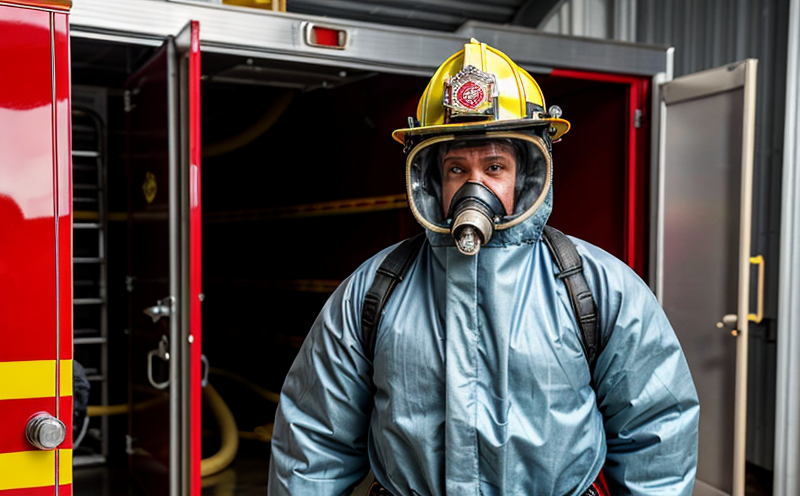Firefighter Protective Clothing & Equipment Testing
The safety of firefighters is paramount in a profession where they face extreme hazards on a daily basis. Firefighter protective clothing and equipment testing ensures that these critical items meet the highest standards of protection, durability, and performance, thereby safeguarding the lives of those who put their own at risk.
Firefighters' protective clothing includes bunker gear (fire-resistant turnout coats, pants, gloves, hoods), boots, helmets, and other essential gear. Equipment can encompass breathing apparatuses, thermal imaging cameras, rescue tools, and more. Each component must undergo rigorous testing to ensure it meets the stringent criteria set by international standards such as NFPA 1971 for protective clothing and NFPA 1983 for equipment.
Testing involves a series of procedures designed to simulate real-world conditions that firefighters might encounter. For instance, bunker gear is tested for flame resistance using methods like the vertical burn test (ASTM F1959) where the fabric is exposed to flames for a specified period and then evaluated based on the amount of burning and damage.
The thermal protective performance (TPP) test evaluates how effectively the clothing protects against heat. This involves placing a thermocouple probe through the garment at various points, exposing it to high temperatures, and measuring the temperature increase until flashover occurs. The difference between this temperature and the ambient temperature provides the TPP value.
For respiratory equipment like SCBA (Self-Contained Breathing Apparatus), tests focus on pressure resistance, airflow rate, and air quality. The apparatus must maintain an airtight seal under high-pressure conditions to prevent leaks that could compromise the firefighter's safety.
The use of these tested products significantly enhances firefighters' ability to perform their duties safely and effectively. Properly equipped firefighters are better prepared to tackle emergencies without compromising their own safety, which is critical for mission success and minimizing risk.
Testing laboratories play a crucial role in ensuring that all protective clothing and equipment meet the necessary standards. By employing state-of-the-art facilities and adhering strictly to internationally recognized protocols, these labs ensure that every piece of gear undergoes thorough evaluation before it reaches the hands of firefighters.
The importance of this testing cannot be overstated. Lives depend on the effectiveness and reliability of the protective clothing and equipment used by firefighters. Ensuring compliance with relevant standards not only protects individual firefighters but also contributes to overall public safety, making these tests invaluable components in the broader context of fire service operations.
Why It Matters
The safety and efficacy of firefighter protective clothing and equipment are crucial for effective firefighting operations. Proper protection ensures that firefighters can perform their duties without endangering themselves, which is critical to mission success. When considering the risks involved in firefighting—such as high temperatures, toxic smoke, and intense heat—it becomes clear why rigorous testing is essential.
- Enhanced Safety: Testing guarantees that protective clothing and equipment meet safety standards, providing firefighters with reliable protection against various hazards.
- Improved Performance: Well-tested gear allows firefighters to perform their tasks more effectively by ensuring that the equipment functions as intended under extreme conditions.
- Minimized Risk: By adhering to strict testing protocols, the risk of injury or death is significantly reduced, protecting both individual firefighters and the communities they serve.
The reliability of these items directly impacts firefighting effectiveness. Reliable protective clothing enables firefighters to focus on saving lives rather than worrying about their personal safety. This focus can lead to more efficient operations and better outcomes in emergency situations.
Furthermore, the use of tested equipment fosters trust among communities, knowing that the firefighters they rely on are equipped with top-notch gear. This trust is vital for maintaining public confidence and support for fire services.
Customer Impact and Satisfaction
- Increased Confidence in Firefighters: When communities know that their firefighters are equipped with rigorously tested protective clothing and equipment, they feel safer knowing that these essential workers are protected.
- Better Performance During Emergencies: Reliable gear allows firefighters to perform more effectively under stress, enhancing the overall success of rescue operations.
- Reduced Risk of Injury or Death: Proper testing ensures that protective clothing and equipment do not fail during critical moments, thereby reducing the risk of injury or death for firefighters.
Customers, in this context, are the communities served by fire departments. The confidence built through the use of tested gear translates into greater support for fire services, which can lead to enhanced resources and better infrastructure development. In turn, these improvements further enhance firefighter safety and effectiveness.
The satisfaction derived from knowing that their local firefighters have access to top-quality protective clothing and equipment is a key factor in community engagement and long-term relationships with public safety agencies.
International Acceptance and Recognition
The testing of firefighter protective clothing and equipment is recognized globally, ensuring that standards are consistent across borders. International acceptance and recognition are crucial for several reasons:
- Consistency in Standards: By adhering to internationally recognized standards like NFPA 1971 and ASTM F1959, manufacturers ensure that their products meet the same rigorous criteria regardless of where they are sold.
- Harmonization Across Borders: This harmonization allows for easier trade between countries, as there is less variation in product specifications. Firefighters from different regions can also use compatible equipment with confidence.
- Enhanced Global Reputation: Products that meet international standards are often viewed more favorably by customers and stakeholders worldwide, boosting the reputation of manufacturers and fire departments alike.
The acceptance of these tests in various countries underscores their importance. Compliance with global standards ensures that protective clothing and equipment can be used safely and effectively in diverse environments around the world. This recognition also fosters collaboration among international fire services, promoting best practices and continuous improvement.
Fire departments from different nations often exchange knowledge and experiences, which further strengthens the global fire safety community. By adhering to these standards, all parties involved contribute to a safer and more efficient firefighting environment worldwide.





